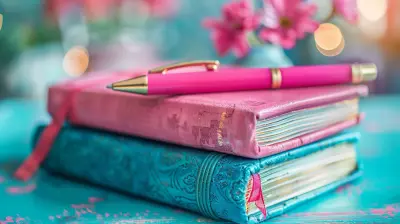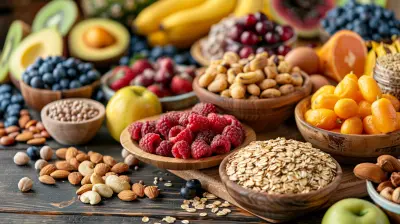Understanding Food Cravings and How to Tame Them
31 May 2025
Ever found yourself reaching for a chocolate bar or a bag of chips even when you’re not particularly hungry? You’re not alone. Food cravings are a universal experience, and they can feel overpowering at times. But have you ever wondered why they happen? More importantly, is there a way to control them without feeling deprived?
In this article, we'll dive deep into the science of food cravings, explore the reasons behind them, and uncover practical ways to manage them without sacrificing your sanity (or your favorite treats!). 
What Are Food Cravings?
Food cravings are intense desires for specific foods. They can be triggered by physical, emotional, or psychological factors. Unlike regular hunger, which is your body’s way of signaling that it needs fuel, cravings are often more about satisfying a particular taste, texture, or emotional need.Cravings can strike at any time, and they tend to favor high-calorie, ultra-processed foods — think chocolate, pizza, fries, or ice cream. But why do we crave these foods, and not, say, a bowl of steamed broccoli? The answer lies within our brain chemistry and hormones. 
The Science Behind Cravings
Cravings are influenced by a complex interplay of hormones, neurotransmitters, and external triggers. Let’s break it down:1. Dopamine and the Reward System
When you eat something delicious (like a gooey chocolate brownie), your brain releases dopamine — the “feel-good” chemical. This neurotransmitter is part of your brain’s reward system, reinforcing the behavior and making you crave that food again in the future.In essence, your brain remembers the pleasure associated with certain foods and encourages you to seek them out again, even when you’re not actually hungry.
2. Hormonal Imbalances
Certain hormonal fluctuations can increase the likelihood of cravings:- Ghrelin: Known as the "hunger hormone," ghrelin increases appetite and peaks before meals.
- Leptin: The "satiety hormone" that tells your brain when you’re full. If leptin levels are low, cravings can spike.
- Cortisol: The stress hormone that can lead to cravings for high-carb or sugary foods as a coping mechanism.
3. Nutrient Deficiencies
Sometimes, cravings can be your body’s way of signaling a deficiency. For example:- Craving chocolate? You might be low in magnesium.
- Craving red meat? It could be an iron deficiency.
- Craving salty snacks? You may need more electrolytes.
Of course, not all cravings are tied to nutritional deficiencies… sometimes, we just really love cookies!
4. Emotional and Psychological Triggers
Ever heard of "stress eating" or eating out of boredom? Emotional triggers play a significant role in cravings. Stress, sadness, loneliness, or even simple habit patterns can make us reach for certain comfort foods.For instance, if you always have ice cream when watching TV, your brain starts associating the two. Even if you’re not actually hungry, your brain nudges you to grab that pint simply because it’s "what you do" while watching your favorite show. 
Common Types of Food Cravings and What They Mean
1. Sweet Cravings – Often linked to low blood sugar levels or stress.2. Salty Cravings – Could indicate dehydration or a mineral imbalance.
3. Carb Cravings (Bread, Pasta, etc.) – Often stem from low serotonin levels, meaning your body is looking for a quick mood boost.
4. Fried or Fatty Food Cravings – May suggest a need for healthy fats, like omega-3s.
5. Chocolate Cravings – Could mean a magnesium deficiency or simply a love for chocolate!
While these interpretations can be helpful, cravings are not always that straightforward. The key is understanding patterns and responding in a mindful way. 
How to Tame Your Food Cravings
The good news? Cravings don’t have to control you. Here are some science-backed strategies to help you curb them without feeling deprived:1. Identify Your Triggers
Pay attention to patterns. Do you tend to crave sweets when stressed? Or salty snacks when tired? Keeping a food journal can help you identify your personal food cravings and their triggers.2. Stay Hydrated
Dehydration can sometimes masquerade as hunger. Next time you have a sudden craving, drink a glass of water and wait 10-15 minutes. You might find the craving disappears.3. Balance Your Meals
Make sure your meals contain:- Protein (e.g., chicken, tofu, eggs)
- Healthy fats (e.g., avocado, nuts, olive oil)
- Fiber (e.g., whole grains, vegetables)
Balanced meals keep blood sugar levels steady and reduce the likelihood of sudden cravings.
4. Get Enough Sleep
Lack of sleep can lead to hormonal imbalances, increasing levels of ghrelin (which makes you hungry) and decreasing leptin (which helps you feel full). Aim for 7-9 hours of quality sleep per night.5. Manage Stress
Since stress increases cortisol levels, finding healthy ways to manage stress can help reduce emotional cravings. Try meditation, deep breathing, yoga, or even a simple walk outside.6. Opt for Healthier Alternatives
If you’re craving sweets, try:- Dark chocolate instead of milk chocolate
- Fresh fruit instead of candy
- Greek yogurt with honey instead of ice cream
For salty cravings, consider:
- Nuts or seeds instead of chips
- Homemade popcorn with spices instead of store-bought versions
7. Don’t Deprive Yourself
Sometimes, trying to cut out a craving completely backfires, leading to overeating later. Instead of banning your favorite foods, enjoy them in moderation. Have a small portion, savor it, and move on.8. Distract Yourself
Cravings usually pass within 15-20 minutes. Engage in an activity like reading, listening to music, or going for a short walk. Often, the craving will fade away.9. Eat Mindfully
Slow down while eating and truly enjoy your food. Eating mindfully can make a small portion feel more satisfying, reducing the urge to overeat or indulge in cravings.10. Get Moving
Exercise releases feel-good endorphins, which can help reduce cravings — especially those linked to emotions. A short workout, stretching session, or even dancing around your living room can work wonders.Final Thoughts
Food cravings are a normal part of life, but they don’t have to dictate your eating habits. Understanding the root causes of cravings, balancing your nutrition, managing stress, and using smart strategies can help tame those pesky urges without feeling restricted.At the end of the day, it's about balance. Enjoy your favorite foods in moderation while fueling your body with the nutrients it actually needs. Cravings don’t have to be the enemy — they can be an opportunity to tune in and listen to what your body is really asking for.
So, next time a craving strikes, ask yourself: Is this true hunger, or something else? You might just surprise yourself with the answer!
all images in this post were generated using AI tools
Category:
Healthy EatingAuthor:

Eileen Wood
Discussion
rate this article
3 comments
Colt Velez
Great article! Food cravings can feel overwhelming, but it's comforting to know we're all in this together. I appreciate the practical tips for managing them—definitely going to try keeping healthier snacks on hand. Here’s to finding balance and enjoying treats guilt-free! 🍏✨
June 16, 2025 at 4:59 AM

Eileen Wood
Thank you for your kind words! I'm glad you found the tips helpful. Here's to a balanced approach and enjoying those treats! 🍏✨
Caitlin Bowers
Great article! Understanding food cravings is a vital step towards healthier eating habits. Your tips are practical and empowering—perfect for anyone looking to regain control over their choices. Keep it up!
June 3, 2025 at 3:18 AM

Eileen Wood
Thank you for your kind words! I'm glad you found the tips helpful. Here's to healthier choices!
Andrea Barrett
This article offers valuable insights into the psychology behind food cravings and practical strategies to manage them. Understanding the triggers can empower readers to make healthier choices and foster a balanced relationship with food. Great read!
May 31, 2025 at 2:30 AM

Eileen Wood
Thank you for your kind words! I'm glad you found the insights helpful.



